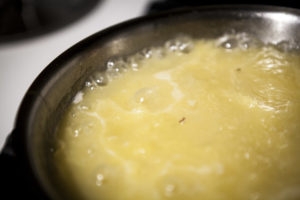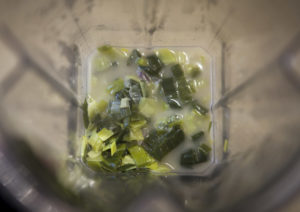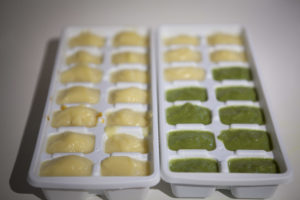
Oh you know, just enjoying some leeks at 6 months of age. Mmm…
When I introduced solids to my now 3 year old son I had little regard for gut health. He ate tons of fruits, vegetables, proteins and healthy fats, but my objective was simply to have a child with a diverse palate for healthy foods. My objective is slightly different for my daughter who has cystic fibrosis. Yes, I want her to have a diverse palate like her brother (who, by the way, will eat almost anything), but I also want her to develop a healthy gut flora, which will be essential for her to develop a strong immune system and ability to properly assimilate nutrients.
Many folks with cystic fibrosis are unable to digest food properly because digestive enzymes released in the pancreas become trapped in sticky mucus that results from the body’s inability to move salts properly. Digestive enzymes can be supplemented in the diet for these folks, but this is just part of the picture. Let’s take a closer look at digestion to understand why:

Spaghetti squash was first baked and then boiled in bone broth till it mostly disintegrated.
Digestion actually begins in your mouth. Your teeth grind the food up into small bits (so, don’t forget to chew!) and digestive enzymes in your saliva start to prepare the food for the stomach. The acids in the stomach further digest the food that is then moved into our small intestines. Here’s where the pancreas comes in… digestive juices from the pancreas are delivered to the villi – the finger-like projections that line the surface of our small intestines. These projections help to create greater surface area for nutrient absorption. But it gets even crazier, because the villi are actually lined with microvilli, which are lined with glycocalyxes – more projections to increase surface area! Without all of the folds of our small intestines, the villi, the microvilli and the glycolyxes, our intestines would have to be 4.5 miles long in order to account for adequate surface area for nutrient absorption (Enders, Gut: the Inside Story of Our Body’s Most Underrated Organ, pg 39). Dang, that’s a whole lotta intestines!
Once food is broken down into it’s smallest parts in the small intestines, it is absorbed into the blood stream (except for fats, which I’ll discuss momentarily). If you have leaky gut syndrome, some of the particles that are being absorbed are not fully broken down, because the lining of the small intestines isn’t properly sealed. Particles can pass through the lining, make their way into the blood stream where they can be transported throughout the body to cause a number of detrimental side effects. Babies have especially permeable guts (complete sealing of a healthy gut occurs around 2yrs of age), which is why it’s important to introduce easy-to-digest foods first to prevent the passing of undesirable food particles into the blood stream.
Nutrient-filled blood is delivered to the liver where it is filtered before being delivered to the heart and then pumped throughout the body. So, there’s a “filter” in effect to attempt to catch some of those particles that accidentally escape. However, this is not the case with fat absorption, which is absorbed directly into our lymphatic system, not into the blood stream. This means that fat DOES NOT pass through the liver for filtration before being sent out to the rest of the body. This is one of the reasons why it’s important to eat healthy fats… there’s no filter system in check.

Leeks were well-cooked in bone broth and are ready for the blender.
Okay, back to the intestines…. After making its way through the small intestines, food is then passed into the large intestines that works in an entirely different way. The large intestines lack the folds and villi of the small intestines, and food therefore moves much slower through the large intestines in order to digest and assimilate nutrients that might otherwise be overlooked such as Calcium, fatty acids, vitamin K, and a variety of B-vitamins.

When first introducing solids, try one food at a time. Now that June eats a variety of veggies, I simply boil everything together making a soup and puree the entire soup.
So, that pretty much covers the human side of digestion. The other important piece to note is that there are billions and billions of bacteria and yeasts (a.k.a. flora) present throughout this process that are aiding in digestion throughout. And the very cool thing is that the flora in your mouth and esophagus is different from the flora in your small intestines, which is different from the flora in your large intestines. There’s very little flora in the stomach since it’s so acidic and very few bacteria/yeast can actually survive in there. Furthermore the highest concentration of gut flora is present in the large intestines, which as we just learned, doesn’t have all of those villi. The purpose of gut flora is to aid in the digestion of our foods. Without it, we’d have incomplete digestion.

She’s ready for those leeks!
Now, back to my baby with cystic fibrosis… As you can see, digestive enzymes are just one piece of the puzzle. Not only do you want a healthy pancreas with the ability to produce enzymes, but you also want a sealed gut and healthy intestinal flora. I’m therefore introducing solid foods in a way that is based on the GAPS Diet, a diet specifically designed to fix an unhealthy gut and a variety of associated ailments. Correcting the gut is much harder than preventing the problem in the first place which is why I’m being especially cautious with my daughter. I want her gut to have the best start in life possible.
I’m first introducing lots of homemade bone broths. I cook bones in my super awesome electric pressure cooker for 2- 4 hours till the bones become brittle (chicken bones) or start to appear to be dissolving (larger beef bones). When cooled, these bones form a “gel” which is exactly what you’re looking for. This gel is not only packed full of essential minerals, but it also contains gelatin (or collagen, whatever you want to call it), which helps to fills those “cracks” in the permeable gut. This is GREAT for babies and anyone who has digestive issues or wants to develop stronger digestion. It’s also great for strong bone development which I blogged about in an earlier post.
I’m also introducing a number of non-starchy vegetables such as zucchini, leeks, spaghetti squash (this isn’t actually very starchy despite how it seems), carrots, leafy greens, etc. I’ll next introduce some meats and eggs for protein, then fruit, and then starchy vegetables. Grains and legumes will be very last and probably come much later. For vegetable preparation, I boil the vegetables in the homemade broth till the veggies are extremely soft. I then blend the mixture with a healthy fat such as the animal fat skimmed from the homemade broth, organic extra virgin olive oil, homemade lard or organic cold pressed coconut oil. Personally, I’m going to introduce the coconut oil at a later point simply because coconut isn’t tolerated well by some, but the other options I listed earlier are all great options.

So, to recap:
- Use lots of homemade bone broths
- First introduce easy to digest foods such as non-starchy vegetables. Later move on to meats, then fruits, then starchy vegetables and very lastly, grains and legumes.
- Incorporate fermented foods and probiotics
- Use a prebiotic as well
Hopefully you’ve found something useful in here and are ready to implement some of these same strategies for your own baby! Leave me a comment below or send me a message if you have something to add or want to ask a question!
Leave a Reply